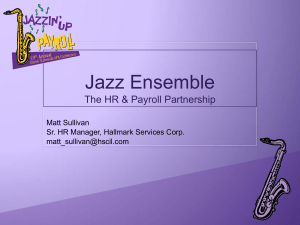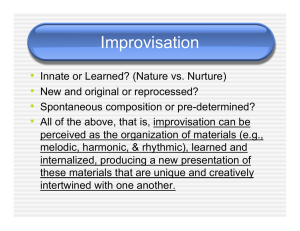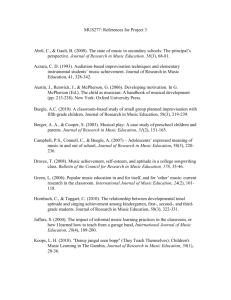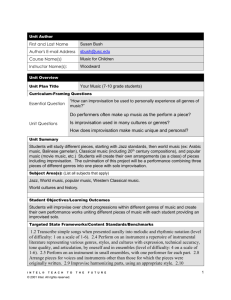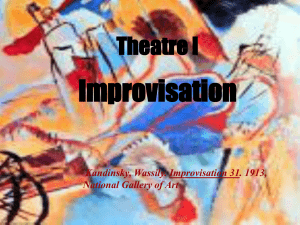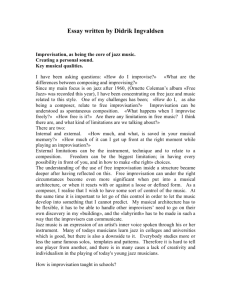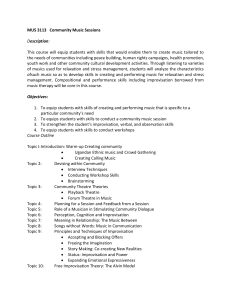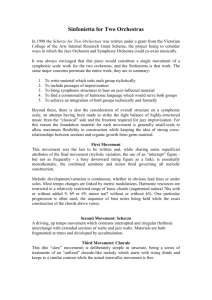Click here for the remainder of Jim`s article which - Conn
advertisement
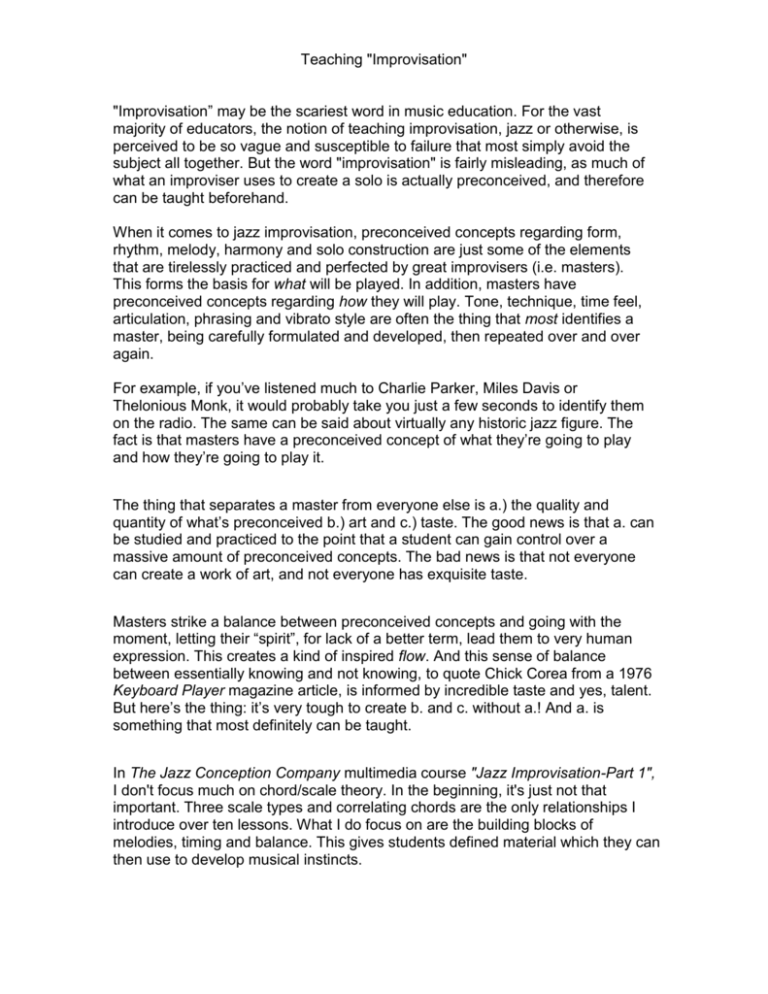
Teaching "Improvisation" "Improvisation” may be the scariest word in music education. For the vast majority of educators, the notion of teaching improvisation, jazz or otherwise, is perceived to be so vague and susceptible to failure that most simply avoid the subject all together. But the word "improvisation" is fairly misleading, as much of what an improviser uses to create a solo is actually preconceived, and therefore can be taught beforehand. When it comes to jazz improvisation, preconceived concepts regarding form, rhythm, melody, harmony and solo construction are just some of the elements that are tirelessly practiced and perfected by great improvisers (i.e. masters). This forms the basis for what will be played. In addition, masters have preconceived concepts regarding how they will play. Tone, technique, time feel, articulation, phrasing and vibrato style are often the thing that most identifies a master, being carefully formulated and developed, then repeated over and over again. For example, if you’ve listened much to Charlie Parker, Miles Davis or Thelonious Monk, it would probably take you just a few seconds to identify them on the radio. The same can be said about virtually any historic jazz figure. The fact is that masters have a preconceived concept of what they’re going to play and how they’re going to play it. The thing that separates a master from everyone else is a.) the quality and quantity of what’s preconceived b.) art and c.) taste. The good news is that a. can be studied and practiced to the point that a student can gain control over a massive amount of preconceived concepts. The bad news is that not everyone can create a work of art, and not everyone has exquisite taste. Masters strike a balance between preconceived concepts and going with the moment, letting their “spirit”, for lack of a better term, lead them to very human expression. This creates a kind of inspired flow. And this sense of balance between essentially knowing and not knowing, to quote Chick Corea from a 1976 Keyboard Player magazine article, is informed by incredible taste and yes, talent. But here’s the thing: it’s very tough to create b. and c. without a.! And a. is something that most definitely can be taught. In The Jazz Conception Company multimedia course "Jazz Improvisation-Part 1", I don't focus much on chord/scale theory. In the beginning, it's just not that important. Three scale types and correlating chords are the only relationships I introduce over ten lessons. What I do focus on are the building blocks of melodies, timing and balance. This gives students defined material which they can then use to develop musical instincts. The first step is to search out a bunch of melodies and melodic fragments, which I'll call "ideas". The best way to find great ideas is by listening to recordings of bona fide giants of jazz and transcribing them. In fact, these recordings are the best source for all elements of improvisation and jazz style. Listening is obviously paramount, and our improvisation course includes over 130 historic audio and video performances. However, transcribing may be a bit daunting for many students, so in the beginning it's fine to use other sources, such as books or course material, to build a collection of ideas. An idea could be something as simple as one or two notes using a syncopated rhythm, a scale fragment or an arpeggio. It could be a blues idea or ideas utilizing timeless concepts such as enclosures of chord tones or lines guided by "goal" notes, all of which I discuss in the improvisation course. Students don't need a ton of ideas when starting out, but they should have a variety of ideas, mostly two measures or less, at their disposal so that they can assemble phrases that sound both interesting and logical. The next step is memorizing these ideas. Students often memorize material in academic courses, so memorizing a musical idea shouldn't be any different than, for example, memorizing the sound and spelling of a word. An effective way to memorize an idea is to relate it to chord tones, for example 1, 2, 3, 5. Try to hear it and visualize either sheet music with the idea or fingerings, then play it. If a student can repeat an idea flawlessly ten times, they've probably got it. Repeat this process with about 15-20 ideas, all over a similar chord (e.g. F7 & Fmi7). Now have students play over a simple form, in this case maybe a blues or an 8measure section on F7 or Fmi7, inserting one idea every 2 measures. Some will be shorter than two measures, so they will rest. Some may be a bit longer than two measures, so after that idea, they might rest for a measure or so, or play a melodic fragment. But they should limit themselves to ideas that they've memorized, and they generally shouldn't be longer than two measures. Why two measures? In the beginning, it's a very natural way to group ideas and create symmetry. It's also much easier to keep your place in the form! Finally, have students focus on the timing of each idea and how they compliment each other (balance). If one idea is active, dense with notes or rhythms, perhaps the next idea should be less active, using just a couple of notes or rhythms. If the contour of an idea ascends, perhaps the next idea might descend, creating a peak. If an idea descends, perhaps the next idea will ascend, creating a valley. This helps students to develop a sense of balance, maybe even taste. All of this is discussed in the improvisation course. When students can reliably execute ideas they've memorized, and have instincts that allow them to assemble ideas in a logical and musical manner, they can say something when "improvising". The more material they have, the more they can say. Eventually, their instincts will allow them to play new things that they just hear at a certain moment, or react to what their bandmates are playing, saying things they've never said. They will then be able to balance their improvisation between "knowing and not knowing". It's powerful stuff, not to mention a whole lot of fun! Jim Snidero is a saxophonist, author and educator living in New York City. He is the president of The Jazz Conception Company, producing multimedia courses on jazz improvisation and performance. Go to www.jazzimprovisation.com to find out more.
